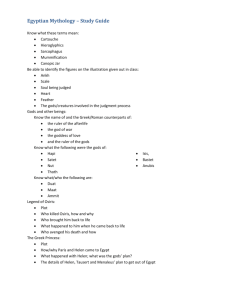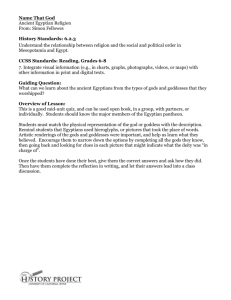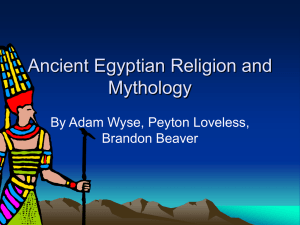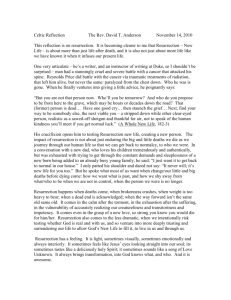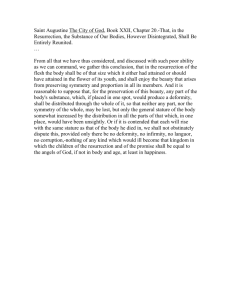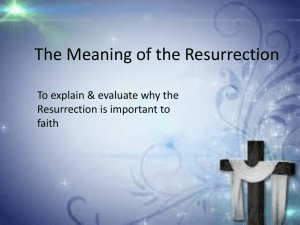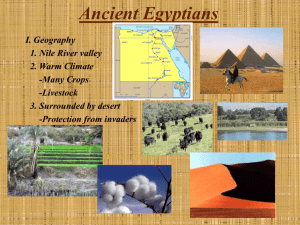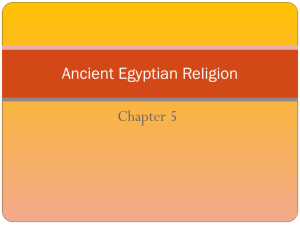Ancient Traditions of Dying Gods
advertisement
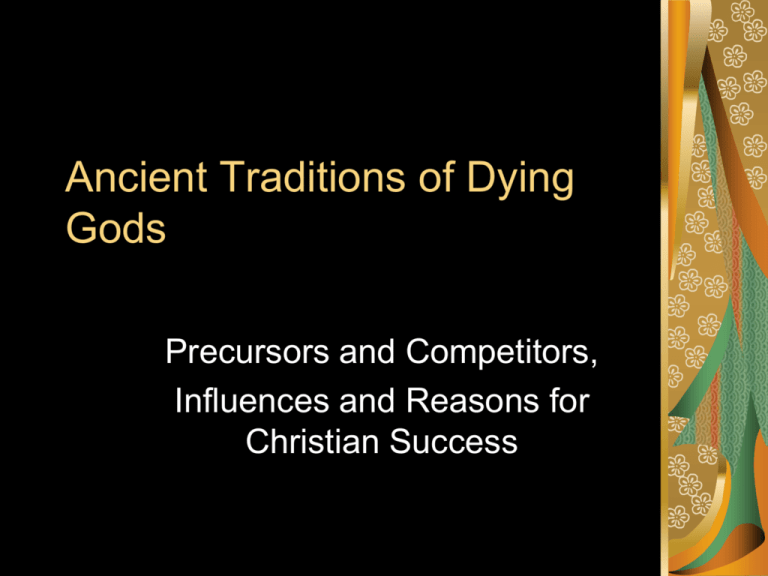
Ancient Traditions of Dying Gods Precursors and Competitors, Influences and Reasons for Christian Success Background Interpreting the Bible as Literature entails examining literary influence, beliefs and forces outside a document that shaped it. One question raised has been the influence of Greek ideas on the concepts and writing of the New Testament. Christianity and the “Greeks” One reason A. D. Nock believed Christianity was “founded” by Paul and was highly successful in the Mediterranean basin was Christianity’s relation to the previous belief of Helenistic and Romanized people. Paul lived in the time of Pax Romana, the “peace of Rome,” and could travel freely to people who spoke the same language and were familiar with Greek, Roman, and Egyptian traditions and gods. Paul translated the gospel for the “Greeks” (Gentiles) and emphasized elements of the gospel they could relate to. Pax Romana Jews, Greeks, and The Gospels Ἐν ἀρχῇ ἦν ὁ Λόγος, καὶ ὁ Λόγος ἦν πρὸς τὸν Θεόν, καὶ Θεός ἦν ὁ Λόγος The synoptic gospels Mark and Matthew relate Jesus to the Jewish concept of the messiah. Many discussions involve Jewish issues—the law, the covenant, etc. Luke and John slant more to the Gentile audience. Luke, being one writing with Acts, foreshadows the efforts of Peter and Paul to reach the Gentiles and it emphasizes the Antioch church. John appears in a time where Christians have been expelled from the synagogues, and the book places the life of Jesus in a Greek context (the sacred “word” of God, Savior of the World) The Jewish Afterlife The scriptural view of death was the dark place “sheol.” The belief in resurrection later combined with the belief in the coming messianic age. “The Hebrew word Olam Ha-Ba ("the world to come") is used for both the messianic age (see below) and the afterlife. A Mishnah passage says, "This world is like a lobby before the Olam Ha-Ba. Prepare yourself in the lobby so that you may enter the banquet hall." Jewish Belief in Resurrection Tehiyat Hameitim: Resurrection of the Dead More developed concepts of the resurrection of the dead and afterlife seem to have entered Judaism under Hellenistic influence after the Torah was completed. It became one of the fundamental beliefs in rabbinic Judaism, the intellectual successors of the Pharisees. The Sadduccees, familiar to New Testament readers as those who denied the resurrection, were an exception. … the resurrection of the dead is one of Maimonides' "13 Articles of Belief," and the frequently-recited Shemoneh Esrei prayer contains several references to the resurrection. From Religion Facts: Jewish Beliefs on the Afterlife http://www.religionfacts.com/judaism/beliefs/afterlife.htm “Pagan” Traditions The word “pagan” is from the Latin “pagani” (“foreigner,” i.e. non-Roman) In the ancient world, most “Gentiles” would have been familiar with the ideas of death and resurrection. There were even “blood baptisms” and rebirths in the cultic rituals (for the Greek gods Cybele and Attis) that involved rebirth through the bathing of the blood of bulls. Ceremonies surrounding the eating of “food offered to idols” was very similar to the rites of the “Last Supper.” see I Corinthians 7 & 8 Dying Gods The most important connection ancients would have had to the gospels was with the concept of the sacrificial or dying god, one who takes on the sins of his/her followers and saves them. Traditional Jews would scoff at the idea of God becoming a man, let alone dying for man’s sins. Greek Christians were more open to the ideas because they were they had precedents in Greek culture. The Mystery Cults "The philosophers of the ancient world were the spiritual masters of the Inner Mysteries... At the heart of the Mysteries were myths concerning a dying and resurrecting godman, who was known by many different names. In Egypt he was Osiris, in Greece Dionysus, in Asia Minor Attis, In Syria Adonis, in Italy Bacchus, in Persia Mithras. Fundamentally all these godmen are the same mythical being." Timothy Freke and Peter Gandy, The Jesus Mysteries - Was the Original Jesus a Pagan God?, 1999, p.4 Attis Like Adonis, he appears to have been a god of vegetation, and his death and resurrection were annually mourned and rejoiced over at a festival in spring. The legends and rites of the two gods were so much alike that the ancients themselves sometimes identified them. Attis was said to have been a fair young shepherd or herdsman beloved by Cybele, the Mother of the Gods, a great Asiatic goddess of fertility, who had her chief home in Phrygia. Some held that Attis was her son. His birth, on December 25th, like that of many other heroes, is said to have been miraculous. His mother, Nana, was a virgin, who conceived by putting a ripe almond or a pomegranate in her bosom. Easter comes from the Germanic Oestra, a mother goddess figure. Romans celebrated “Hilaria” in honor of the mother goddess on March 25th. See http://www.tektonics.org/copycat/attis.html for various explanations of the “godmen” Osiris "The central figure of the ancient Egyptian Religion was Osiris, and the chief fundamentals of his cult were the belief in his divinity, death, resurrection, and absolute control of the destinies of the bodies and souls of men. The central point of each Osirian's Religion was his hope of resurrection in a transformed body and of immortality, which could only be realized by him through the death and resurrection of Osiris." E. A. Wallace Budge, Osiris & the Egyptian Resurrection, 1973 (1911), Preface Osiris The Osiris myth is the most elaborate and influential story in ancient Egyptian mythology. It concerns the murder of the god Osiris, a primeval king of Egypt, and its consequences. Osiris' murderer, his brother Set, usurps his throne. Meanwhile, Osiris' wife Isis restores her husband's body, allowing him to posthumously conceive a son with her. The remainder of the story focuses on Horus, the product of Isis and Osiris' union, who is first a vulnerable child protected by his mother and then becomes Set's rival for the throne. Their often violent conflict ends with Horus' triumph, which restores order to Egypt after Set's unrighteous reign and completes the process of Osiris’ resurrection. From Wiki “Osiris” Mithras The Mithraic Mysteries were a mystery religion practised in the Roman Empire from about the 1st to 4th centuries AD. The name of the Persian god Mithra, adapted into Greek as Mithras, was linked to a new and distinctive imagery. Worshippers of Mithras had a complex system of seven grades of initiation, with ritual meals. Initiates called themselves syndexioi, those "united by the handshake".[6] They met in underground temples (called mithraea), which survive in large numbers. The cult appears to have had its centre in Rome.[7] "the Mithraic Mysteries had no public ceremonies of its own. The festival of natalis Invicti [Birth of the Unconquerable (Sun)], held on 25 December, was a general festival of the Sun, and by no means specific to the Mysteries of Mithras. From Wiki “Mithras” Frazier’s Golden Bough Prior to the birth of Christianity the ancient world was full of mythology, rituals, ceremonies, and religious beliefs that conformed on many levels with what later became the fundamental doctrines of Christianity. This fact may be unknown to most practicing Christians today, or at least ignored, but it has been a common understanding in the secular intellectual world since at least 1890. That was the year in which Sir James G. Frazer's book The Golden Bough was first published. Frazier’s Golden Bough In this volume, now universally recognized as a classic, Frazer became the first mainstream scholar to highlight the common themes found throughout the myths and legends of many different cultures, themes that predated Christianity but which were still very similar—the most important of these being the story of a dying and rising god. The Saviors of the Ancient World by Peter Goodname, Part Three of The Giza Discovery http://www.redmoonrising.com/Giza/DyingandRising3.htm J.Z. Smith’s Challenge According to J.Z. Smith, the entire category of "Dying and Rising" gods was a fabrication, and all of the deities placed in this category, upon close inspection, proved to be either gods who disappeared and then returned, but did not die, or deities who died and then never rose. For Smith it was either one or the other, but never both, as Frazer had claimed for a multitude of pagan deities and which happened in the case of Jesus Christ. Smith even stated that in some cases it appeared that Frazer was "strongly influenced by the wish to demonstrate that Christianity was not an innovation, but that all its essential features are to be found in earlier religions." Mettinger’s Response “In his book,” The Riddle of Resurrection, [Tryggve] Mettinger makes a meticulous examination of the Near Eastern gods that have been placed at one time or another under the heading of "Dying and Rising" gods. These include Ugaritic Baal, Melqart-Heracles, Adonis, Eshmun-Asclepius, Dumuzi-Tammuz, and Osiris. For Mettinger the question is simple: is there any evidence—literary or inscriptional, ritual or mythological—that any of these gods were ever understood by the people that worshiped them as having actually died and then returned to life again? It is a simple question but Mettinger does not believe that the scholars who have reacted against Frazer's thesis have been completely honest. Slides 6-12 from The Saviors of the Ancient World by Peter Goodname, Part Three of The Giza Discovery http://www.redmoonrising.com/Giza/DyingandRising3.htm Goodname’s Summary Near the end of his book Mettinger concedes that a strange connection does exist between Christianity and the "Dying and Rising" gods of paganism. However, he does not believe that the existence of this pre-Christian phenomenon must necessarily mean the non-existence of the Jesus Christ of New Testament Christianity. Here is what he writes, "There is, as far as I am aware, no prima facie evidence that the death and resurrection of Jesus is a mythological construct, drawing on the myths and rites of the dying and rising gods of the surrounding world. While studied with profit against the background of Jewish resurrection belief, the faith in the death and resurrection of Jesus retains its unique character in the history of religions. The riddle remains." For more specifics, review Goodname’s excellent overview of Mettinger’s findings: The Saviors of the Ancient World by Peter Goodname, Part Three of The Giza Discovery http://www.redmoonrising.com/Giza/DyingandRising3.htm C.K. Chesterton “In answer to the historical query of why it was accepted, and is accepted, I answer for millions of others in my reply: because it fits the lock; because it is like life. It is one among many stories; only it happens to be a true story. It is one among many philosophies; only it happens to be the truth.” C.S. Lewis “here and here only in all time the myth must become fact; the Word, flesh; God, Man.” J. R.R. Tolkien “this story is supreme; and it is true. Art has been verified. Legend and history have met and fused” Slides 15 through 17 from Montgomery, John Warwick, Chesterton the Apologist. Patrick Henry College. Web http://phc.edu/gj_montchesterton.php A Secular Source Wilson is a master of delivering the most information in the fewest words. His style is fascinating and clearly credible. I simply had to read this book in two settings. I came away with an excellent understanding of the short version of remarkably complex research material. Amazon Reviewer
